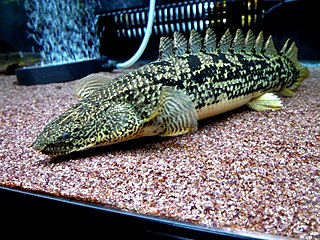
Bichirs and the reedfish comprise Polypteridae, a family of archaic ray-finned fishes and the only family in the order Polypteriformes.

Rajiformes is one of the four orders in the clade Batomorphi, often referred to as the superorder Batoidea, flattened cartilaginous fishes related to sharks. Rajiforms are distinguished by the presence of greatly enlarged pectoral fins, which reach as far forward as the sides of the head, with a generally flattened body. The undulatory pectoral fin motion diagnostic to this taxon is known as rajiform locomotion. The eyes and spiracles are located on the upper surface of the head and the gill slits are on the underside of the body. Most species give birth to live young, although some lay eggs enclosed in a horny capsule.
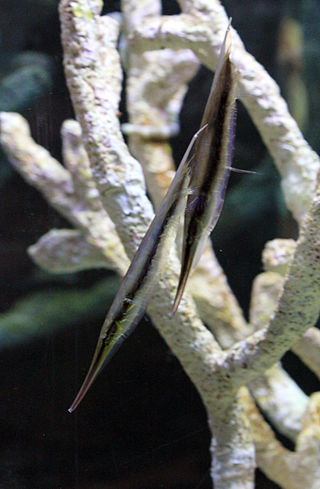
The Centriscidae are a family of fishes from the order Syngnathiformes which includes the snipefishes, shrimpfishes, and bellowfishes. A small family, consisting of only about a dozen marine species, they are of an unusual appearance, as reflected by their common names. The species in this family are restricted to relatively shallow, tropical parts of the Indo-Pacific.

The cusk-eel family, Ophidiidae, is a group of marine bony fishes in the Ophidiiformes order. The scientific name is from the Greek ophis meaning "snake", and refers to their eel-like appearance. True eels diverged from other ray-finned fish during the Jurassic, while cusk-eels are part of the Percomorpha clade, along with tuna, perch, seahorses and others.

The blackspot shark is a small species of requiem shark in the family Carcharhinidae found in the tropical Indo-West Pacific Ocean between latitudes 24°N and 30°S, from the surface to a depth around 40 m (130 ft). Its length is a little under one meter (yard) and it is not considered to be dangerous to humans. It feeds mainly on fish, crustaceans, and squid. This shark is also caught in small-scale fisheries for human consumption.

The longnose pygmy shark is a rare species of squaliform shark in the family Dalatiidae and the only member its genus. It is known only from a handful of specimens collected from the cold oceanic waters of the Southern Hemisphere, between the surface and a depth of 502 m (1,647 ft). Reaching 37 cm (15 in) in length, this diminutive shark is characterized by a slender, dark brown body with a very long, bulbous snout. In addition, it has two spineless dorsal fins of nearly equal size, with the origin of the first lying over the pectoral fin bases. The longnose pygmy shark does not appear substantially threatened by fisheries, and has been assessed as Least Concern by the International Union for Conservation of Nature (IUCN).

The Australian sawtail catshark is a common species of deepwater catshark, belonging to the family Pentanchidae, endemic to southern Australian waters. It is found on or near the bottom of the outer continental shelf and upper continental slope, at depths of 85 to 823 m. This slim-bodied species is characterized by crests of enlarged dermal denticles along both the dorsal and ventral edges of its caudal fin and caudal peduncle, along with a color pattern of broad, dark saddles outlined in white. It can grow to 61 cm (24 in) in length. The Australian sawtail catshark feeds mainly on fishes, crustaceans, and cephalopods. Females are oviparous and lay eggs enclosed by capsules. This species is often caught incidentally by commercial bottom trawl fisheries, but is not significantly threatened by fishing activity. Thus, it has been assessed as of Least Concern by the International Union for Conservation of Nature (IUCN).

The mouse catshark is a species of shark belonging to the family Pentanchidae, the deepwater catsharks. It is common in the northeastern Atlantic Ocean from Iceland to Western Sahara. There is much taxonomic confusion regarding this species in Icelandic waters, where it may be confounded with another species of Galeus or Apristurus. Probably not exceeding 49 cm (19 in) long, the mouse catshark has a uniformly brown body and is characterized by large, rounded pelvic fins and crests of enlarged dermal denticles along both the dorsal and ventral caudal fin margins. In addition, in adult males the inner margins of the pelvic fins are merged into an "apron".

The tentacled flathead, also known as the Indian Ocean crocodilefish, Madagascar flathead or longhead flathead, is a species of marine ray-finned fish belonging to the family Platycephalidae, the flatheads. This species is in the western Indian Ocean, including the Red Sea and the Mediterranean, having invaded as a Lessepsian migrant through the Suez Canal. It is the only species in the monotypic genus Papilloculiceps.
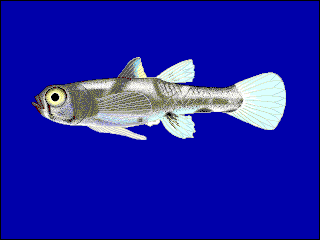
The dwarf pygmy goby or Philippine goby is a tropical species of fish in the subfamily Gobionellinae from brackish water and mangrove areas in Southeast Asia. It is one of the smallest fish species in the world. Males reach maturity at a standard length of 0.9 cm (0.35 in) and can reach up to 1.1 cm (0.43 in) in standard length, while the females can grow up to 1.5 centimetres (0.59 in) in total length. Adults weigh around 4 milligrams (0.00015 oz). It is known as bia and tabios in the Philippines.
Breitensteinia is a genus of catfishes of the family Akysidae. It includes three species.

Paraplotosus is a genus of catfishes native to Australasia and South-east Asia.
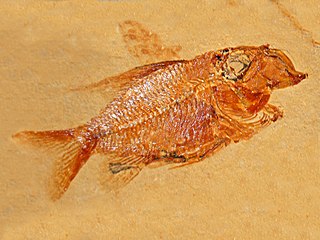
Lissoberyx is an extinct genus of prehistoric ray-finned fish belongon to the family Trachichthyidae. Lissoberyx is a trachichthyid, but it shows more resemblance to the holocentrids than any other trachichthyid.

Davichthys is an extinct genus of prehistoric marine ray-finned fish related to modern ladyfish. It is known from the Late Cretaceous of southern Europe, the Middle East, and North Africa. It is one of the earliest known elopids.
Figaro is a genus of shark, and part of the family Pentanchidae, the deepwater catsharks. Until 2008, Figaro was generally considered to be a subgenus of Galeus, the sawtail catsharks. The two known species are found off Australia, inhabiting deep, offshore waters on or near the bottom. Figaro contains small, slender, firm-bodied sharks that bear distinctive crests of enlarged, spiny dermal denticles along the dorsal and ventral edges of their short caudal fins. The caudal peduncle is relatively long, such as that the anal and caudal fins are some distance apart. In adult males, the inner margins of the pelvic fins are fused together to form a subtle "apron" over the claspers. F. boardmani is a predator of fishes, crustaceans, and cephalopods, and is oviparous; less is known about the F. striatus. Both are harmless and are of no economic importance.

Agonus is a monospecific genus of ray-finned fish belonging to the subfamily Agoninae in the family Agonidae. Its only species is Agonus cataphractus, commonly known as the hooknose, pogge or armed bullhead. This is a demersal fish found in the coastal waters of the northeastern Atlantic Ocean.
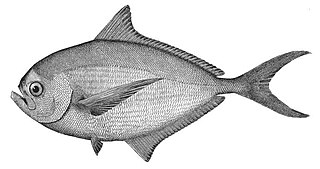
Brama is a genus of marine ray-finned fishes from the family Bramidae, the pomfrets. Currently, there are 8 species within the genus.
Oxyurichthys petersii, commonly known as Peters' goby, is a species of ray-finned fish, a goby, from the family Oxudercidae. It is native to the Red Sea, and has now colonised the eastern Mediterranean Sea by Lessepsian migration through the Suez Canal.

Tselfatiiformes is an extinct order of bony fishes from the infraclass Teleostei. The order represents the most important radiation of marine teleosts during the Cretaceous period. Fossils of tselfatiiforms are known from Europe, North America, central and northern South America, the Middle East and North Africa.
Bambradon is a monotypic genus of marine ray-finned fish belonging to the family Bembridae, the deepwater flatheads. Its only species, Bambradon laevis, is found in the northwestern Pacific Ocean off Japan.















